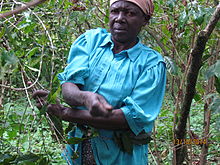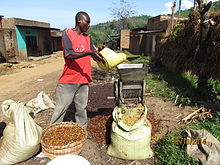Mujje Tulye from Uganda/Growing coffee in Mbale
Coffee in Uganda
[edit | edit source]

Coffee is Uganda's top-earning export crop. In 1989 Uganda's coffee production capacity exceeded its quota of 2.3 million bags, but export volumes were still diminished by economic and security problems, and large amounts of coffee were still being smuggled out of Uganda for sale in neighbouring countries.
Some coffee farmers cultivated cocoa trees on land already producing robusta coffee. Cocoa production declined in the 1970s and 1980s, however, and market conditions discouraged international investors from viewing it as a potential counterweight to Uganda's reliance on coffee exports. Locally produced cocoa was of high quality, however, and the government continued to seek ways to rehabilitate the industry. Production remained low during the late 1980s, rising from 1,000 tons in 1986 to only 5,000 tons in 1989. The Uganda Coffee Development Authority was formed in 1991 by government decree, in line with the liberalization of the coffee industry.
Arabica coffee grows around the slopes of Mount Elgon. The coffee was introduced to Uganda from Ethiopia and naturalised along the slopes of Mount Elgon.
Robusta coffee grows natively in the Kibale forest area. From 1999 to 2002 an effort was made to commercialize this coffee as a premium consumer brand, emulating and extending the success of shade grown in Central America. Revenue from the coffee production was intended to finance conservation management activities.
Source: Wikipedia
Growing coffee in Mbale
[edit | edit source]






Mbale is a city in Eastern Uganda. It is the main municipal, administrative and commercial center of Mbale District and the surrounding sub-region.
Below are the following steps of growing coffee in Mbale.
The first requirement is a piece of land preferably around or on the mount Elgon, where Arabica coffee thrives in Uganda. It can be several pieces of land since the possibility of getting one big piece is minimal.
Planting coffee or maintaining existing trees (pruning, weeding,). Coffee is a perennial crop and so it would take you about four years before you can get a good harvest from the trees. On the other hand if you inherited trees on your piece of land, you could be able to get a good harvest during the harvesting period. In preparation of planting coffee one would need to dig holes for the seedlings. In these holes, layers of soil and manure should be placed before putting the seedlings. Manure is usually got by digging compost pits where the farmers place organic waste from the homestead. Some farmer have cows and mix the dung with the compost manure. Maintaining old trees will require weeding around the plants, pruning, and maintaining the shade trees that help the coffee thrive. Some trees were planted in the 1950’s, 1960’s, and 1970’s and are still producing berries.
All the above is done in preparation for the wet season. During the wet season the farmer would mainly maintain the garden and other crops that he would have planted for home consumption like beans, vegetables, peanuts etc.
When the harvesting period approaches, the farmer will gradually harvest depending on when the berries ripen. For over a month, the farmer will keep taking off the red ripe berries.
During the harvesting period several activities take place. After taking the red berries, the farmer will pulp them using a pulping machine which will give one berries and coffee husks. The berries are dried to a certain level of moisture. Most farmers use the sun to dry the coffee berries but some farmers with large harvest will take their produce to the Bugisu cooperative factory. Where it will be put in a machine to carry out the process from the pulping to the drying of the coffee.
Coffee is then put in sacks which are weighed and transported to the bugisu cooperative union. Where the farmers sell their coffee to the cooperative. The coffee is tested for moisture and quality before being bought by the cooperative.
Farmer is then paid for his coffee and will be eligible to get a bonus if the coffee is sold abroad at a good profit.
Source: Wikiuganda blog https://wikiuganda.wordpress.com/2014/12/10/growing-coffee-in-mbale/